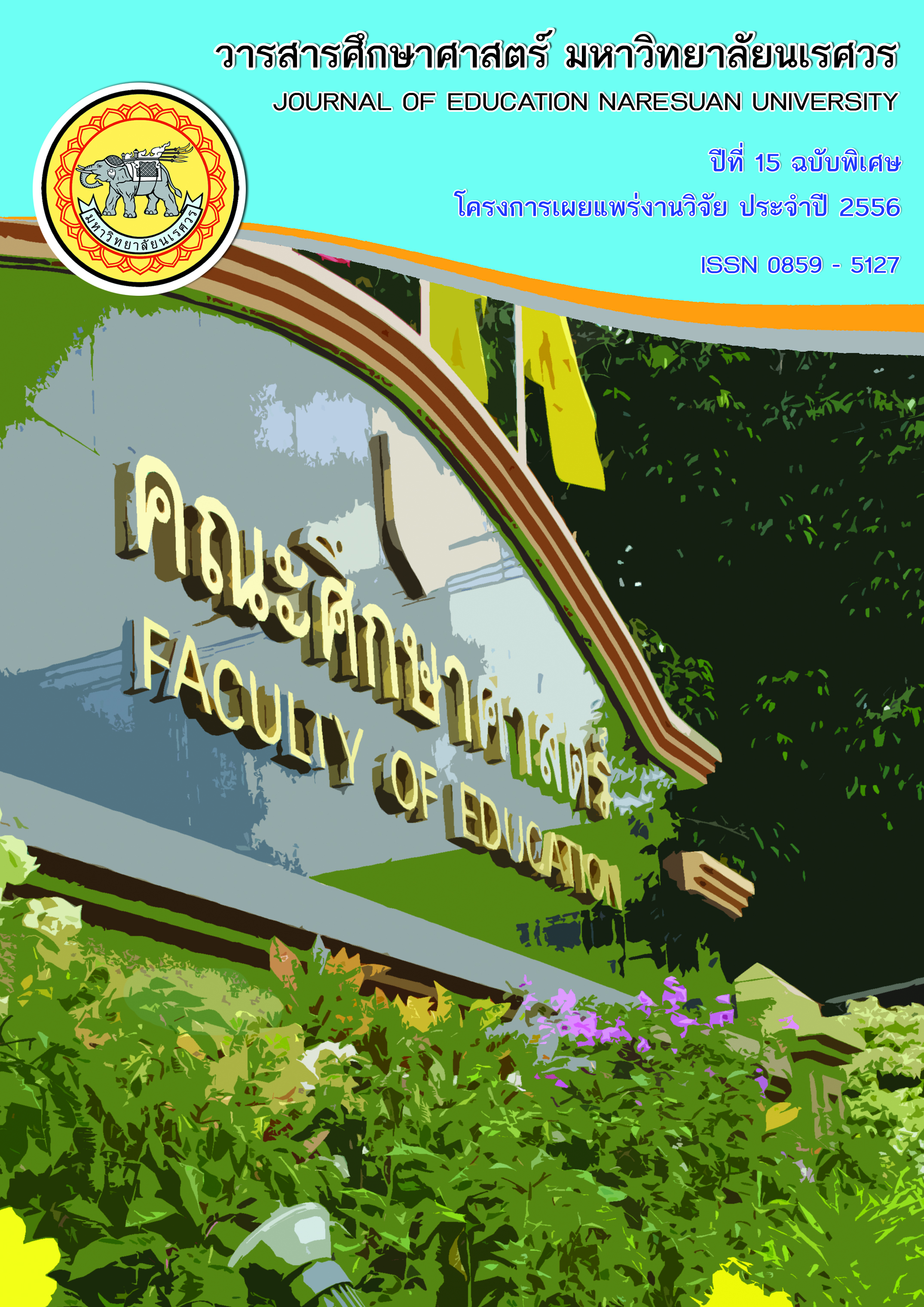รูปแบบการพัฒนาครูเพื่อศิษย์ในสถานศึกษา สังกัดสำนักงานเขตพื้นที่การศึกษาประถมศึกษา
Main Article Content
Abstract
บทคัดย่อ
การวิจัยครั้งนี้มีจุดมุ่งหมายเพื่อพัฒนารูปแบบการพัฒนาครูเพื่อศิษย์ในสถานศึกษา สังกัดสำนักงานเขตพื้นที่การศึกษาประถมศึกษา มีขั้นตอนการวิจัย 3 ขั้นตอน ขั้นตอนที่ 1 การศึกษาคุณลักษณะและวิธีการพัฒนาครูเพื่อศิษย์ในสถานศึกษา สังกัดสำนักงานเขตพื้นที่การศึกษาประถมศึกษา ใช้วิธีวิเคราะห์เอกสารและสัมภาษณ์ผู้ทรงคุณวุฒิ จำนวน 12 คน ขั้นตอนที่ 2 สร้างรูปแบบการพัฒนาครูเพื่อศิษย์ในสถานศึกษา สังกัดสำนักงานเขตพื้นที่การศึกษาประถมศึกษา โดยนำผลการศึกษาจากขั้นตอนที่ 1 มาใช้ แล้วตรวจสอบความเหมาะสม โดยการประชุมระดมความคิดของผู้ทรงคุณวุฒิ จำนวน 9 คน ขั้นตอนที่ 3 ประเมินความเป็นไปได้และความมีประโยชน์ของรูปแบบการพัฒนาครูเพื่อศิษย์ที่สร้างขึ้น โดยจัดประชุมสัมมนาผู้บริหารการศึกษา ผู้อำนวยการกลุ่ม ผู้บริหารสถานศึกษา และครูผู้สอน จำนวน 40 คน แล้ววิเคราะห์ข้อมูลโดยค่าเฉลี่ย และส่วนเบี่ยงเบนมาตรฐาน
ผลการวิจัยปรากฏ ดังนี้
1. คุณลักษณะครูเพื่อศิษย์ในสถานศึกษาสังกัดสำนักงานเขตพื้นที่การศึกษาประถมศึกษา ประกอบด้วย คุณสมบัติที่สำคัญ 5 ด้าน ได้แก่ ด้านคุณธรรม มีคุณลักษณะ 12 ประการ ด้านการจัดการเรียนรู้ มีคุณลักษณะ 15 ประการ ด้านความรู้และทักษะ มีคุณลักษณะ 12 ประการ ด้านเครือข่ายการจัดการเรียนรู้ มีคุณลักษณะ 5 ประการ และด้านการมีข้อมูลเกี่ยวกับคุณลักษณะและทักษะผู้เรียน มีคุณลักษณะ 4 ประการ
กระบวนการพัฒนาครูเพื่อศิษย์ในสถานศึกษา สังกัดสำนักงานเขตพื้นที่การศึกษาประถมศึกษามีกระบวนการ 5 ขั้นตอน คือ วินิจฉัยความต้องการจำเป็น กำหนดจุดประสงค์และขอบข่ายการพัฒนา กำหนดวิธีการพัฒนา ดำเนินการพัฒนา และประเมินผลการพัฒนา
ทั้งนี้ มีปัจจัยที่ส่งผลต่อการพัฒนาครูเพื่อศิษย์ 9 ปัจจัย คือ เจตคติต่อวิชาชีพครู ความรู้ทางวิชาชีพ แรงจูงใจใฝ่สัมฤทธิ์ การพัฒนาตนเอง การจัดกระบวนการเรียนรู้ ภาวะผู้นำทางวิชาการ ทีมงาน วัฒนธรรมการเรียนรู้ ผู้มีส่วนได้ส่วนเสีย และวิธีการพัฒนามี 15 วิธี คือการฝึกอบรม การดูตัวอย่างโดยการฝังตัว การศึกษาจากคู่มือ การฝึกอบรมเชิงปฏิบัติการ การพัฒนาตนเองให้มีหลักวิชา หลักคิด หลักปฏิบัติ การพัฒนาตนเองโดยแสวงหาความรู้รอบด้านแล้วสรุปข้อเท็จจริง การศึกษาความสำเร็จของผู้ร่วมงานและเพื่อนร่วมวิชาชีพ การจัดการความรู้ การเป็นที่ปรึกษา การสอนงาน การเป็นพี่เลี้ยง การเป็นกัลยาณมิตร รู้ทุกข์ รู้สุข กิจกรรมการคุยกับเพื่อนครูเพื่อพัฒนาการเรียนการสอน การเสวนาเป็นเนืองนิตย์สร้างกลุ่มที่หลากหลายขยายสู่ชุมชน และกิจกรรมแลกเปลี่ยนภายในโรงเรียนและระหว่างโรงเรียนกับชุมชน
2. รูปแบบการพัฒนาครูเพื่อศิษย์ในสถานศึกษา สังกัดสำนักงานเขตพื้นที่การศึกษาประถมศึกษาที่ผู้วิจัยสร้างขึ้น มีองค์ประกอบสำคัญ 3 ส่วนคือ องค์ประกอบเชิงระบบ กระบวนการพัฒนา และระดับการพัฒนา ในองค์ประกอบเชิงระบบนั้น มุ่งสู่ผลผลิตซึ่งเน้นคุณลักษณะครูเพื่อศิษย์ 3 ด้าน ได้แก่ ด้านการปฏิบัติตน ด้านความรู้และทักษะ และด้านการปฏิบัติงาน ที่ส่งผลไปยังคุณลักษณะและทักษะผู้เรียน ส่วนกระบวนการพัฒนาครูเพื่อศิษย์ มี 5 ขั้นตอน คือ วินิจฉัยความต้องการจำเป็น กำหนดจุดประสงค์และขอบข่าย กำหนดวิธีการพัฒนา ดำเนินการพัฒนา ประเมินผลการพัฒนา และระดับการพัฒนาครูเพื่อศิษย์ 3 ระดับ ได้แก่ระดับบุคคล ระดับกลุ่ม และระดับองค์การ
3. ผลการประเมินรูปแบบการพัฒนาครูเพื่อศิษย์ในสถานศึกษา สังกัดสำนักงานเขตพื้นที่การศึกษาประถมศึกษา พบว่ามีความเป็นไปได้ในการนำไปปฏิบัติอยู่ในระดับมาก และมีประโยชน์อยู่ในระดับมากที่สุด
คำสำคัญ: ครูเพื่อศิษย์/ การพัฒนาครู/ โรงเรียนประถมศึกษา
Abstract
This research aimed at initiating a model for student-oriented teacher development for the schools under the jurisdiction of Primary Education Service Offices. The specific objectives were three-folds: 1) to identify the teachers’ characteristics and the desirable procedure for the development of these teachers; 2) to formulate the model for the development of the student-oriented teachers; and 3) to assess the applicability and usefulness of the model. The research methodology was based on mixed methods. In the first stage, the selected documents were analyzed and 12 experts were interviewed. In the second stage, the results from the first stage were used for model drafting then the appropriateness of the drafted model was reviewed by 9 experts in a focus group discussion meeting. In the third stage, a seminar was conducted so that 40 educational administrators, section director, school administrators, and teachers were involved and their opinions on the applicability and usefulness of the model were asked. Mean and Standard Deviation were used for data analysis in the third stage.
The findings were as follows:
1. The characteristics of student-oriented teachers for the schools under the jurisdiction of the Primary Education Areas Offices should involve 5 dimensions: Ethics, comprising 12 characters; Instruction Abilities, comprising 15 characters; General Knowledge and Skills, comprising 12 characters; Instructional Networking Abilities, comprising 5 characters; and Information about Personality and Skills of Each Student, comprising 4 characters.
The process for the development of student-oriented teachers in the schools under jurisdiction of Primary Education Service Area Offices involved five steps; needs assessment; purposes and framework identification; determination of methods; training and/or development; and evaluation.
There were nine influential factors to the success in developing of the student-oriented teachers were: attitudes towards teaching profession; professional knowledge; achievement motives; self-development; instruction process; academic leadership; working team; learning culture; and, stakeholders. In addition, there were 15 development methods: training; best-practice shadowing; manual studying; workshop; self development of academic, thinking, and performing principles; self development through knowledge induction; reviewing of peers’ successes; knowledge management; working as an advisor; coaching; mentoring; being an intimate friend (a buddy); dialogues with peers on instruction development; occasional dialogues with various groups in the community; and, knowledge exchange within school and between school and community.
2. The model for development of the student-oriented teachers comprised three major elements; the development system, the development process, and the development levels. The development system focused on developing the student-oriented teachers whose characteristics were categorized as Personal Characters, General Knowledge and Skills, and Performance Characters, Which influenced to the student-Characters and Skills. The development process involved the five steps–needs assessment, purposes and framework identification, determination of methods; training and/or development, and evaluation. The development levels were divided into personal level, group level, and organizational level.
3. The evaluation by the experts revealed that the model for development of the student-oriented teachers was highly applicable. The usefulness of the model was rated at the highest.
Key words: student-oriented teachers/ teacher development/primary schools
Article Details
The owner of the article does not copy or violate any of its copyright. If any copyright infringement occurs or prosecution, in any case, the Editorial Board is not involved in all the rights to the owner of the article to be performed.


